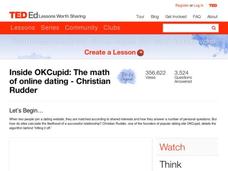Curated OER
Inside OKCupid: The Math of Online Dating
Capture the hearts of your young statisticians with this real-life example of using statistics in online dating. The use of average and geometric mean are discussed in the context of creating the algorithm used to connect people.
Khan Academy
Algebra: Graphing Lines 1
Viewers will learn how to graph lines, such as y=2x+1. The instructor emphasizes the relationship between the x and y variables, creates an x/y table, and finally graphs the equation. A total of three examples are given in this video.
Khan Academy
Recognizing Linear Functions, Linear Equations and Functions
Starting with a set of values for the x and y variables, this video shows how to tell whether these points determine a linear or non-linear function. Sal first defines linear functions in terms of the change in y over the change in x,...
Anywhere Math
Frequency Tables and Histograms
If the shoe fits, include it in the display. The presentation uses shoe size to introduce organizing data within a frequency table and a histogram. Using another histogram, the video outlines how to interpret the data display. To...
Anywhere Math
Stem-and-Leaf Plots
Keep the leaves on the stem for mathematical success. Using the lengths of telephone call data, an informative video goes through the steps to create a stem-and-leaf plot. The presenter shows how to read and interpret data in a...
Crash Course
ANOVA Part 2: Dealing with Intersectional Groups: Crash Course Statistics #34
A statistic of interest is often affected by multiple variables. Continuing from the previous lesson in the Crash Course Statistics playlist, the instructor explains how to apply the ANOVA calculations to multiple variables that have an...
Crash Course
Plots, Outliers, and Justin Timberlake - Data Visualization Part 2: Crash Course Statistics #6
How many ways can you visualize data? An informative video showcases data representations, with specific attention to stem-and-leaf plots and box plots. Viewers also learn to identify and interpret outliers in data.
TED-Ed
How To Spot A Misleading Graph
A source that includes a graph may not always be the best reliable. A short resource highlights how graphs and charts can be misleading. Learners view actual graphs and note the way the graph is distorted to make a point.
Mathed Up!
Stem and Leaf Diagrams
Order the data within a stem-and-leaf display. Pupils take data and create and ordered stem-and-leaf diagrams, including the key. Participants take their data and determine answers about the information. Class members then find...
Mathed Up!
Scatter Graphs
Make an estimate by getting in line. The class works with scatter plots and lines of best fit to make an estimate for given values. Pupils determine whether there is a positive or negative correlation and draw a best-fit line. Using the...
Mathed Up!
Pie Charts
Representing data is as easy as pie. Class members construct pie charts given a frequency table. Individuals then determine the size of the angles needed for each sector and interpret the size of sectors within the context of frequency....
National Education Association
Scatter Plots
What's my line, anyway? A video covers the aspects of finding an equation of the best-fit line for a set of data. It works through plotting the points to drawing a line that appears to represent the data. The presenter suggests finding...
Northeast Arkansas Education Cooperative
Construct and Interpret a Cumulative Frequency Histogram
The finer points of telling the difference between cumulative and frequency histograms are laid out with clear examples for how to get from one to the other. From defining vocabulary through converting charted data to histogram form,...












